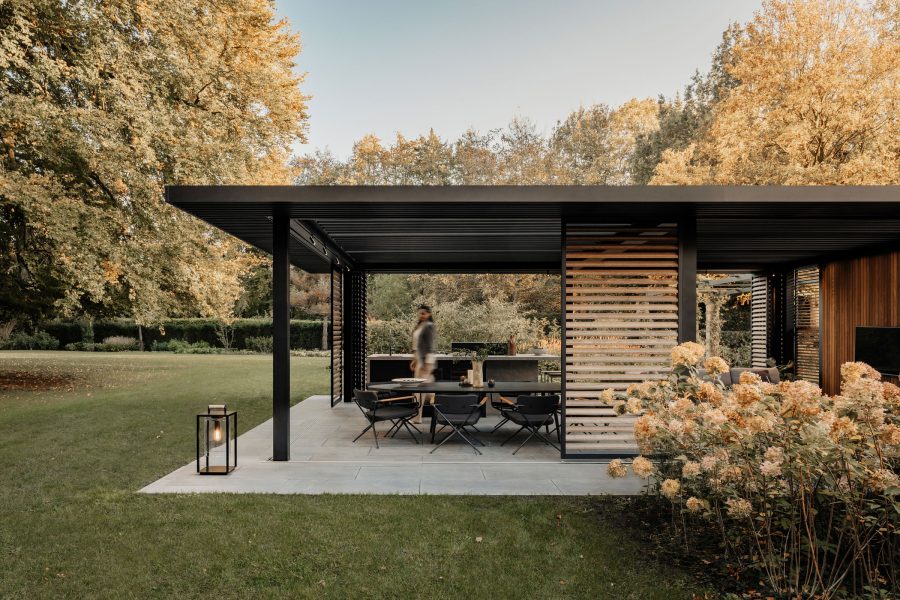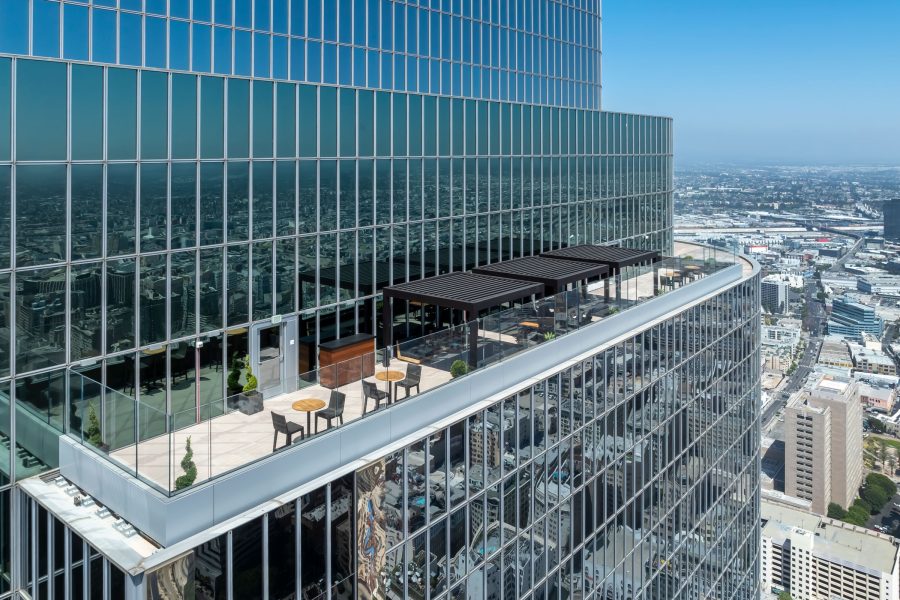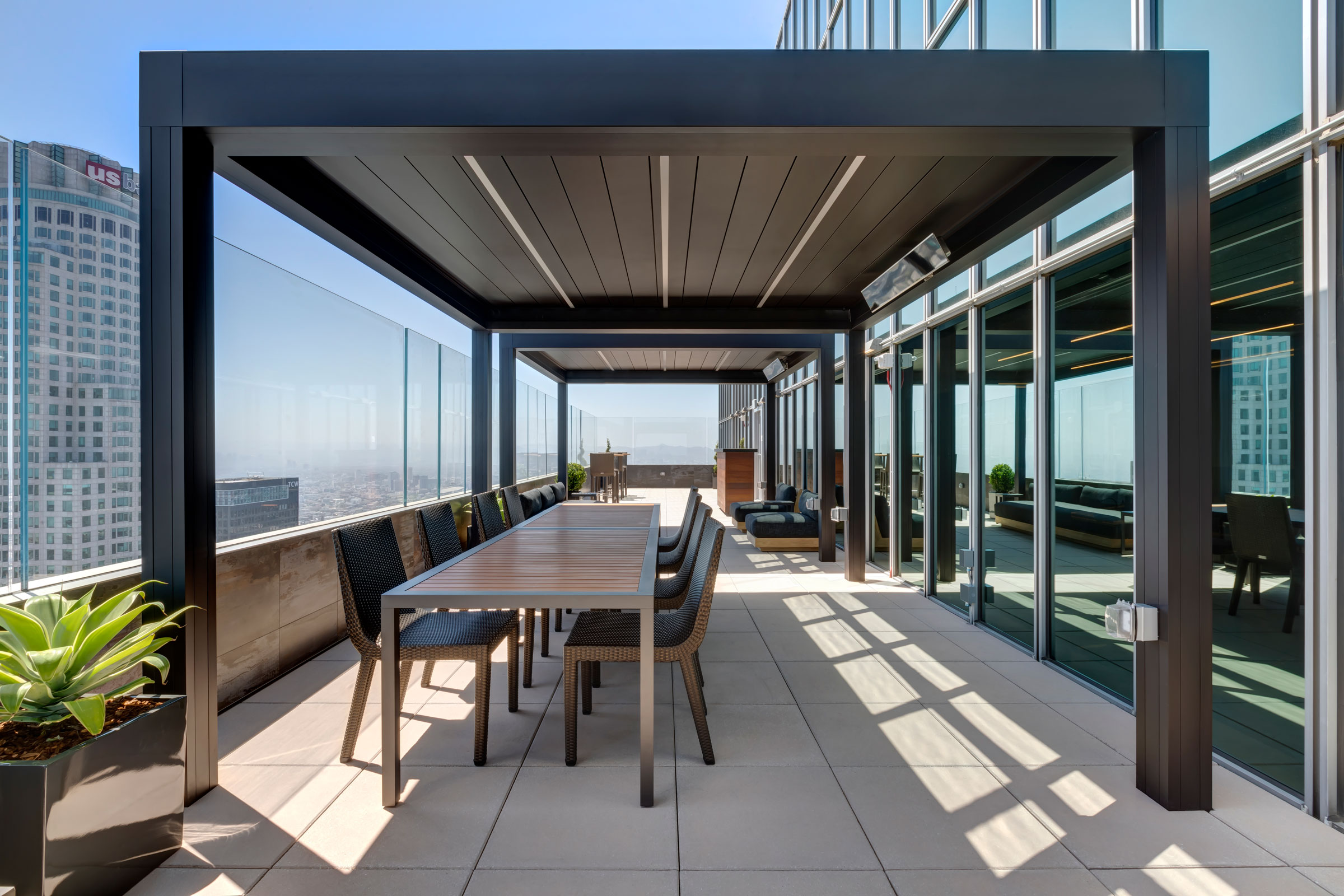Story at a glance:
- Climate change is pushing manufacturers to use more sustainable, weather-resistant, and noncombustible materials.
- Outdoor living products are becoming highly customizable, which expands their applications and saves time for architects.
- As the indoors spill into the outdoors, interior designers are playing a larger role in creating cohesive spaces.
When Saskia Denys, sales director of the west US region at Renson, started her job seven years ago, people didn’t seem to know much about healthy outdoor living spaces. Since then she’s watched the industry evolve as more people embrace sustainable outdoor living.
“My job was to knock on architects’ doors and talk about healthy spaces, ventilation solutions, external shading, and outdoor living solutions, and nobody knew what I was talking about,” she says. “It was so new, and it was very frustrating in the beginning to try to push the concept of healthy living. Now more and more people are asking me questions about it.”
Climate change is a driving force behind this shift and is pushing manufacturers toward more sustainable, noncombustible, and weather-resistant materials, Denys says. For example, the Los Angeles wildfires in January 2025 brought awareness to the need for more durable materials, like aluminum, for facades.
“One of the reasons the wildfires were so bad was because everything was made out of wood, which burns super-fast before you even have time to put out the fire,” she says. “So cladding is moving more toward aluminum, which is noncombustible, more sustainable, and durable. We recently innovated aluminum with a wood look, because people still like the warm feeling that wood creates.”
Customization is King

Amani has the benefits of a pre-engineered modular system while remaining highly customizable. Photo by Hannes Otte, courtesy of Renson

In March 2025 Renson launched Amani in the US. The motorized freestanding pergola offers multiple ways to tailor sunlight, shade, and aesthetics. Photo by Hannes Otte, courtesy of Renson
The pandemic caused a growing demand for customization in outdoor living spaces as people searched for comfortable ways to escape within their own homes, and this demand has continued to grow post-pandemic, Denys says. In March 2025 Renson launched Amani in the US. Amani is a motorized freestanding pergola offering multiple ways to tailor sunlight, shade, and aesthetics with folding and sliding panels, curtains, retractable and rotating roof blades, and increased lighting options.
Denys says Amani has the benefits of a pre-engineered modular system while remaining highly customizable, which saves architects time and energy. “Architects are very creative beings, and they like to do something unique in their products, but they don’t want to spend all of their time engineering a system from scratch,” she says. “Amani is that perfect in-between.”
Customization also won Renson a project from a competitor to work on City National 2CAL in downtown Los Angeles, which they completed in June 2024. Renson worked with Sark Custom Awnings on a 51st floor corporate space, where they built a patio cover with a pool table, kitchenette, and outdoor lounge areas doubling as meeting spaces.
“The competitor was very rigid in terms of changing their base plates. However, we swapped out our standard base plates with seismic plates, which have bars integrated inside for reinforcement, and we were able to get it engineered to go on the 51st floor,” Denys says.
Blending Indoors and Out

Renson also offers Linarte Wood Design—a range of vertical aluminum facade cladding with the look of wood. Photo courtesy of Renson
In addition to more customization happening outdoors, the indoors are increasingly spilling outside to create a more cohesive space that maximizes well-being, according to Anna Kobalyan Dulgeryan, interior designer at Gensler.
For example, Gensler prioritized wellness when designing the headquarters for Marlin Equity Partners in Hermosa Beach, California. The building, just one block from the ocean, has a two-story lobby filled with sunlight and indoor-outdoor spaces that are fully intertwined so employees can feel the ocean breeze and look at greenery while they work.
“There is a strong SoCal surfer culture living and working in Hermosa Beach, so it was important to connect the interior and exterior spaces,” Dulgeryan says. “We used full sliding glass partitions on the second floor, where the interior lounge, pantry, conference rooms, and office open onto the patio. Similarly, we brought the outside in, using a glass sawtooth ceiling through the lobby to bring in natural light.”
Who is responsible for blending indoor and outdoor spaces? Denys says interior designers are playing a larger role in creating outdoor spaces, leading to more cohesion. While four parties are typically involved in creating an outdoor space—an architect, landscape architect, builder, and interior designer—she says the balance is shifting more toward the interior designer. They now choose colors, fabric, and lighting options to create a cohesive look in a project inside and out.
“Previously you could clearly see that different parties designed the indoor and outdoor spaces, and they didn’t always have the same vibe and color pattern,” she says. “For example, if there’s a teak detail on the inside of a building, previously they might have gone with ash for the wooden slats in our outdoor sliding panels. Now the interior designer might say, ‘Hey, let’s match that with the teak on the inside.’ Or if there are different temperatures of lighting causing a mismatch between the inside and outside, those details are more thought out now.”
Health Benefits of Outdoor Spaces

Outdoor spaces are growing in demand across commercial projects. A 2CAL project in Los Angeles includes shaded areas to work or take breaks. Photo by RMA Architectural Photography, courtesy of Renson
Some indoor activities are also moving outdoors, providing health benefits, Denys says. Office spaces in particular are being moved outside and, like in the 2CAL project, becoming a meeting space for workers.
“We have several office projects in Southern California where pergolas or motorized systems are used as outdoor meeting rooms. Before meetings would happen inside of the building in little cubicles, and now there are these spaces outside, which is healthy as well,” she says.
Denys credits the pandemic with reminding people that when they spend more time outside, they feel better. “With the pandemic we transformed into indoor people, but we still have those same needs as outdoorsmen that are in our genes. The pandemic really reinforced that,” she says. “People started to realize that their true nature is being outside; when we are outside, we feel freer, and it’s better for our overall well-being.”

